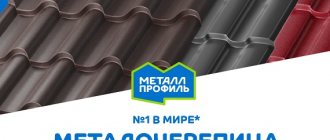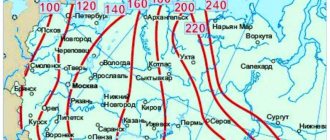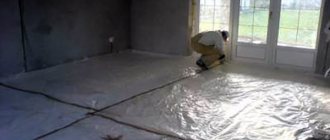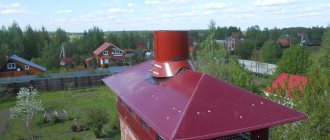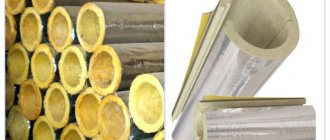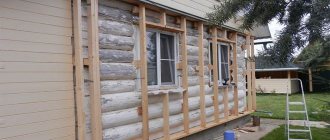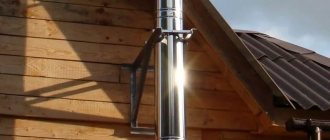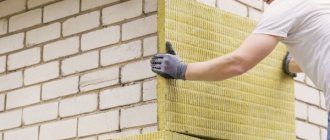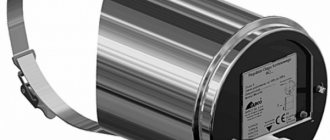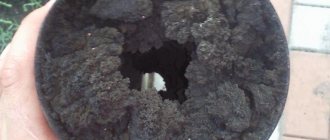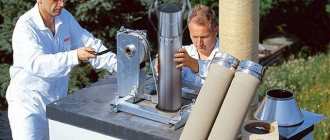Brick chimneys necessarily require additional insulation. High-quality insulation of a brick chimney means significantly extending its service life.
This is explained by the fact that insulating a brick chimney allows you to create conditions under which condensation will not settle on its walls, i.e. the dew point is placed outside the brick pipe.
If you answer the question of whether it is necessary to insulate a chimney, in the negative, significant differences in the temperature of the outside air and that located inside the chimney will lead to the formation and settling of condensate on the internal walls of the pipe. When it comes into contact with the surface of the wall, the moisture will absorb all the fuel combustion products deposited on the walls. As a result of complex chemical processes occurring in this case, one of the elements deposited on the walls becomes sulfuric acid, leading to premature failure of the pipe.
It is necessary to decide how to insulate a brick chimney pipe and what materials to use before completing the roofing work.
To perform insulation work, it is necessary to use materials that fully meet fire safety requirements. It is better to carry out the specified work directly at the construction stage.
What causes a chimney to deteriorate?
The thermal insulation of a chimney does not always guarantee its long service life and full satisfaction of all your expectations.
Quite often, when doing insulation with your own hands, pipes can soon begin to collapse, lose their tightness, and become deformed. There are certain reasons for this, the most common of which you can find below: Even basalt insulation for a chimney, if the pipe itself is incorrectly positioned or the installation process is violated, may become unsuitable. In this case. Increased dampness occurs in the system
Excessive humidity is caused by the settling of warm air vapors on the inner surface of the system, which in turn form condensation, which leads to destruction; Without knowing how to insulate a chimney, it is important to remember that during the use of a heating unit running on solid fuel, the surface and materials are exposed to various sulfuric, carbonic, and nitric acids, which can also cause destruction. This is especially likely if you use the fireplace or stove irregularly, with a lot of downtime.
Correct exit and securing of a pipe when passing through a brick wall of a house
We suggest you read: Is a vapor barrier necessary when insulating a house with mineral wool?
Insulate yourself or call a professional
It is better to entrust the laying of a fireplace chimney, stove or installation and connection of a gas boiler to specialists.
Thermal insulation work itself is a completely feasible task for any owner. Before starting work, it is important to understand the essence of the physical processes leading to the destruction of the structure and choose the right insulation.
Important points in the construction of a furnace
In order for the water circuit to function with maximum efficiency, not only the heating water system must be properly designed, but also the furnace itself. Just maintaining order is not enough
Full compliance with furnace construction technology is important
Foundation
Its type and thickness depend on the size of the stove. It is recommended to install a massive classic Russian stove on a solid strip foundation. For smaller modern heating structures, a concrete pad one and a half ten centimeters thick, sometimes on a frame made of reinforcement, is sufficient.
Brick
For external walls, ceramic refractory bricks are used. For the base - his own, possibly second-hand. Experts recommend that you always line the inner surface of the firebox with fireclay stone. For a more presentable appearance of the facade, it can be laid with facing bricks right away or this finishing can be done later.
Solution
The mortar for masonry is prepared traditionally: sand is mixed with clay, diluted with water and a little cement is added for strength. You can purchase a ready-made cement-based masonry composition with special additives.
Masonry
The main condition for a strong structure is the presence of high-quality ligation of seams. They must not coincide under any circumstances. It is ideal when the seams of the bottom brick row fall under the middle of the bricks lying in the next row. To do this, starting the rows, alternate whole bricks and their halves.
Stoves with a water heating body have a fairly simple and understandable design. They are popular due to their low cost and ease of use. And if you don’t like using natural gas to heat your home or don’t have access to a gas network, this heating option should be considered first. Built by a good craftsman, such a stove never disappoints its owners.
Advantages and disadvantages of a brick chimney
Despite the fact that the metal pipe is no longer exotic, chimneys continue to be laid from brick. In some ways this looks like an anachronism, but there are good reasons why you should not abandon the classic technology of laying smoke exhaust ducts.
The main one is that brick has high thermal inertia. The exhaust hot gases heat it slightly, which significantly reduces the fire hazard of the heating device. We must not forget about another aspect - the temperature of the smoke at the upper end of the pipe should not fall below 60–70 degrees. Otherwise, condensation will flow through it. The brick acts as the shell of a thermos and prevents the smoke from cooling down too much.
But there are two fatal drawbacks:
- Difficulty of masonry.
- Weight.
A column with a base area of no more than 0.25 square meters. meters, its entire mass presses on the stove. This is a concentrated load. If the total height of the pipe exceeds 5 meters, then it is placed on a separate base and connected to the heating device with an adapter pipe.
Why insulate the chimney pipe from the outside?
Chimneys are made from various materials. It can be either refractory brick or metal, asbestos cement, reinforced concrete.
During operation of heating equipment, a large amount of combustion products and hot air masses move through the smoke channel. All this negatively affects the service life of the chimney, because... Corrosion processes are accelerated and the internal walls of the outlet channel are oxidized. If the pipes are made of metal, then there is also a high probability of a fire if there are errors during operation.
Most often, the chimney is damaged for a number of reasons:
- The presence of moisture in the chimney pipe means increased pressure and constant humidity. Due to the fact that the temperature inside and outside the chimney varies, moisture collects on the walls of the ducts, which negatively affects the condition of the structure.
- Chemical environment - when solid or liquid fuel burns, many aggressive substances appear that are dangerous to human health. If the chimney functions well, without failures, then all the formed substances are removed outside under the influence of natural draft. When the draft decreases and during the inactivity of the smoke exhaust structure, substances begin to accumulate on the walls of the smoke channel, this will lead to the pipe slowly beginning to collapse.
Insulating the chimney from the outside using modern thermal insulation materials significantly reduces the likelihood of damage and reduces the rate of corrosion processes.
Expert advice
Installation of thermal insulation of the boiler chimney must be carried out in compliance with installation norms and standards:
- the thermal insulation layer must be completely continuous, including in areas adjacent to the attic floor and roof elements;
- vapor barrier material is installed with the inscriptions facing out;
- the joining of sandwich pipe bends is carried out in such a way that the pipe of the lower bend fits inside the upper bend of the sandwich;
- external thermal insulation is carried out after the construction of the chimney, insulation from the inside is carried out during the process of its arrangement;
- if the roof is made of flammable building materials, then the chimney must be equipped with a spark arrester;
- All manipulations with mineral wool must be carried out using personal protective equipment to prevent particles from getting into the eyes and respiratory tract.
How to insulate a chimney pipe
The choice of materials for insulating pipes in the attic and outside is small, but to this list you can also add fibrous insulation, loose slag concrete, expanded clay, broken brick (construction rubble) and foam glass.
It makes no sense to compare the cost of these insulation materials, since each of them has its own physical structure, technical and operational characteristics. Therefore, how to insulate a chimney is chosen according to location. The main criteria are the material of the chimney in the house, the ease of work and the effectiveness of the result. We can only give general recommendations on choosing insulation:
- Do not use flammable insulation materials under any circumstances;
- Any insulation must be light, flexible and porous or loose;
- Even light thermal insulation can overload the roof elements, so there is no need to complicate the design.
In practice, several methods of attaching insulation are used, and they depend on the selected material. A pipe made of asbestos cement or metal (round) can be insulated from the outside with your own hands as follows: wrap it in mineral or basalt wool and secure it with clamps or wire, or put a metal casing on the fixed thermal insulation material. The second option: there is no need to wrap the pipe - it is covered with special cinder blocks of a special shape, and, if necessary, the top is insulated with mineral wool. More information about these technologies:
- Before insulating a metal or asbestos-cement pipe, purchase insulation with a thickness of at least 100 mm - any mineral or basalt wool will shrink when wrapped around the pipe, so a thick layer will not hurt. After attaching the insulation with clamps or soft steel wire, the thickness of the mineral wool layer should be at least 60 mm;
- When attaching a heat insulator with wire, it is prohibited to use wire in flammable insulation - electrical wires. As the chimney heats up, it can melt the insulation or even set it on fire. Even if the insulation does not catch fire, the physical parameters of the thermal insulation and the integrity of the insulation layer will be compromised;
- Instead of clamps or wire, you can wrap a sheet of galvanized or stainless steel around the pipe. The sheet should be no more than 1 mm thick so that it is convenient and easy to wrap and fasten the edges with rivets or screws. You can calculate the width of the sheet by finding out the circumference of the pipe, and it can be measured with a regular tape measure, adding 20-25 mm to the result for the overlap, where rivets or screws will be attached;
- The optimal height of such a sheet is more than a meter, so that a wind protection in the form of an umbrella can be conveniently mounted on top of it. It is advisable to roll the seam or protect it with bitumen mastic. If the seam is rolled, it is necessary to ensure that it looks inside the pipe - this way less rainwater and snow will get into it;
- The last step when insulating an external chimney pipe is the installation of a protective wind cone-umbrella, which will protect the chimney opening not only from turbulence, but also from precipitation.
This insulation technology is the simplest, fastest, most economical and cheapest.
Do-it-yourself insulation installation
To fully insulate a chimney in a house, you will need to prepare in advance all the necessary tools, a sufficient amount of building materials and protective equipment.
Required tools and materials
The set of tools and materials for thermal insulation work should consist of:
- hammer drill;
- tape measure and marker;
- Bulgarians;
- screwdriver;
- metal scissors;
- a sharp knife for cutting insulation material;
- metal profile;
- vapor barrier film;
- nails and screws;
- hammer;
- safety glasses, gloves, respirator;
- basalt insulation.
Calculation of the dimensions of the structure
When calculating the thickness of the thermal insulation layer, it is necessary to take into account the type of fuel that is used to heat the room, since the temperature inside the chimney depends on it. Thus, for a chimney of a solid fuel boiler, the thickness of the thermal insulation of areas extending beyond the roof should be from 50 mm to 100 mm; for areas passing through an insulated attic, 30 - 50 mm is sufficient.
If the heating device runs on gas or diesel fuel, then the thickness of the thermal insulation layer must be at least 20 - 30 mm.
To calculate the amount of insulation material you will need to take measurements:
- external diameter of the insulated structure;
- length of the smoke exhaust duct;
- the size of the pipe section from the inlet pipe.
So, for example, for a metal chimney with a length of 5 m and a diameter of 219 mm, it is necessary to purchase cylinders of basalt wool with a total length of 5 running meters. 50 mm thick with an internal diameter of 219 mm or 3.5 m² of sheet insulation. As a protective casing, you will need a galvanized product with a cross-section of 273 mm.
Work progress
Thermal insulation work using mineral insulation is carried out according to the following scheme:
- Preparatory work. Cut a hole in the roofing with a diameter 20 - 30 cm larger than the cross-section of the pipe. The chimney surfaces are cleaned of dust and dirt. If the pipe is steel, then it is treated with an anti-corrosion compound.
- Installation of sheathing. The horizontal profile is attached to the chimney using dowels and nails, with a distance between the elements equal to the width of the mineral wool slabs. The lower profile of the sheathing is additionally fixed to the roof rafter system with self-tapping screws. Then the vertical posts are attached to the horizontal guides using a self-tapping screw.
- Installation of insulation. Mineral wool slabs are installed in the cells of the sheathing by surprise. To prevent sagging, the insulation is additionally fixed to the pipe with dowels in several places.
- Vapor barrier. The top layer of insulation is covered with a vapor barrier membrane. The sheets of material are laid overlapping, secured to the metal profile with self-tapping screws, and the joints are sealed with special tape.
- Cladding of the structure. For finishing, you can choose plaster, galvanized frame or metal siding.
- Seal the hole in the roof. The gaps around the chimney are sealed with heat-resistant material and closed with a metal penetration - a casing.
Types of chimneys
Pipes are made from different materials, which we will consider in more detail.
Brick
Classic brick chimneys for gas boilers are still in demand, regardless of their many disadvantages and weak thermal characteristics. At the same time, they meet sanitary standards and rules, which state:
- The pipe is made of fireclay bricks.
- To build the walls, a clay solution or special glue is used.
- To improve draft, the chimney rises above the level of the roof ridge.
Standards regulate the height of the pipe in relation to the roof ridge depending on the distance between them. Source kamin-estet.ru
- The masonry ensures tightness.
- At the internal hole, the deviation is no more than 3 mm per 1 m.
- To protect against precipitation, a deflector is installed on the head of the pipe.
The chimney can also have a mono design, which, due to low thermal characteristics, is repaired every 5-7 years.
Galvanized pipe
The “sandwich” type device today is the most effective option for chimney designs. The undoubted advantage of these chimneys is their resistance to aggressive environments and various mechanical influences.
The product consists of two pipes of different sizes, with one inserted into the other. Basalt wool is usually used as a filler between them.
Coaxial chimney
Currently, gas boilers use closed combustion chambers. Here, air enters and smoke is exhausted by a coaxial pipe. This is an original device, relatively recently introduced, but already very popular among users.
The non-standard solution lies in the supply of air through a pipe that removes combustion products. It turns out that one pipe performs two functions due to the design features.
A coaxial chimney is a pipe in a pipeSource rubankom.com
And its characteristic difference from ordinary pipes is the following... A smaller pipe (60-110 mm) is located in a larger diameter pipe (100-160 mm) in such a way that they do not touch each other.
At the same time, the structure is a single whole due to jumpers along the entire length and is a rigid element. The inner pipe serves as a smoke exhaust, and the outer pipe serves to supply fresh air.
Air exchange at different temperatures creates draft and sets the air mass in directional movement. The air in the room is not used during operation of the boiler, thus maintaining the microclimate in the room.
Ceramic
Such a chimney is a composite structure that includes:
- Smoke exhaust duct made of ceramic material.
- A layer of insulation or air space.
- Expanded clay concrete outer surface.
This complex design is due to several reasons. First, the chimney pipe is too fragile to be left unprotected.
The ceramic tube is always located inside some solid blockSource heatylab.com
Secondly, ceramics have high thermal conductivity, and therefore it needs reliable insulation. The inner round pipe has a smooth surface, while the outer one has roughness that does not affect the integrity of the product.
Typically, such chimneys are produced in lengths from 0.35 to 1 m, depending on the manufacturer. The connection of the inner and outer pipes occurs through a lock, which is a thinning in outer size at one end and an expansion of the inner pipe at the other end.
The expanded clay concrete outer surface is made of a square shape with a round hole inside. In addition, this product provides space for insulation, which is held in place by metal bridges. At the same time, they are fixed on the outer surface and make the pipe securely fastened.
Stainless steel
A steel gas chimney seems to be more reliable than a brick one. They are resistant to corrosion, immune to temperature fluctuations, and are not affected by increased air humidity and aggressive environments.
Stainless steel chimneySource pech-kamin.ru
In addition, such stainless steel pipes have a number of advantages:
- Long period of operation.
- Multifunctionality.
- Relatively low cost.
- Great strength.
- Possible implementation of a product of any complexity.
Chimneys made of this material are characterized by an assembly of modules, which allows the replacement of a damaged segment if necessary. The installation of chimneys is done using special outlets that allow them to fit harmoniously into certain roof elements.
Conclusion
In conclusion, I would like to note that insulating the chimney will not solve all problems. After all, the chimney itself constantly needs timely maintenance. It is necessary to periodically inspect it, clean it and maintain it in proper condition.
If necessary, make proper repairs, which you now know how to do yourself. This will be the key to its high-quality, uninterrupted operation. And for you - a warm, cozy and safe home.
In the video presented in this article you will find additional information on this topic.
The role and functions of insulation
People living in areas with harsh climatic conditions often face the problem of rapid destruction of the chimney. The reason for this is sudden temperature changes, the appearance of condensation, freezing, and then subsequent defrosting of the walls of the chimney saturated with moisture. Thanks to high-quality thermal insulation, of course, it will not be possible to avoid the appearance of condensation, but it will protect the chimney from freezing and thereby extend its service life.
Among other things, warm flue gases, passing through a cold pipe, are noticeably cooled, but at the same time they heat the walls of the chimney. The level of thrust depends on the heating time of the walls. If it is insufficient, carbon monoxide returns back to the heating device, and from there - inside the house, which is fraught with very disastrous consequences, including poisoning. To avoid this, it is necessary to perform high-quality insulation of the smoke duct. Thanks to it, the pipe will warm up faster, and fumes will escape through the least resistance.
Advice! To achieve the most efficient heating of the chimney, it is advisable to construct it from stainless steel. The steel pipe heats up very quickly - in just 2-5 minutes.
Where to insulate
Insulation is required in places where the warm surface of the pipe comes into contact with the outside air. This happens in the cold attic space and after being brought to the roof. When doing work with your own hands in your own home, you need to take care not only of chimneys, but also of ventilation ducts, which also need insulation.
Condensation always falls on the side of the passage of warm air. In the case of a chimney, this will happen inside the pipe, which will lead not only to its damage, but also to moisture rolling down to the heating device, worsening draft. To prevent this, it is necessary to prevent the pipeline from cooling.
Thermal insulation of the chimney pipe
What material to use
First of all, it is important to choose a material that will not contain toxic substances, can safely contact the pipe, and is not affected by fungus
It is recommended to note that the material can be found on construction markets in the form of rolled rolls, sheets, slabs and mats
Thermal insulation cylinder
The use is relevant if the chimney is in the form of a metal structure. It consists of two pipes of different diameters: the first is smaller, acting as a chimney pipe.
Thermal insulation cylinder
Stainless steel is used as the main material. It withstands the effects of acidic substances, which often form on the inside of the chimney. To carry out lining, the pipe must have a large diameter of 6-10 cm, which will act as a casing. Basalt insulation is poured into the free space. Some craftsmen make this material themselves at home, or purchase it at construction markets.
Mineral wool
The material is suitable for insulating chimneys and stoves. This is due to the fact that the insulation is able to favorably withstand even the highest temperature fluctuations, exposure to chemicals, and is also used as internal or external insulation.
There are 4 types of insulation depending on the use of material, structure, length or thickness: slag wool, fiber, stone, basalt. Thermal insulation and chemical properties depend on the structural features. If you plan to carry out furnace insulation from the outside, it is better to use basalt mineral wool. This is a material that is optimally suited for brickwork, since basalt has low thermal conductivity, is heat-resistant, and does not contribute to the spread of mold or mildew.
Specialists cut the sheets to suitable sizes. The material is wrapped around the pipe, and then the insulation is secured with wire. If it is necessary to install sheets of greater thickness, then a metal grid is used, which is fixed throughout the entire area.
Gaps must be sealed. As a rule, a special substance or tape is used for this purpose. Brick is suitable as cladding.
EPPS
The optimal solution is if the chimney is made of brickwork. It has increased durability and is completely waterproof. Category G2 includes Technoplex, Penoplex. Thermal insulating and fire-resistant classes G3, G4 are considered to have lower ratings. For use in coal or wood stoves. The inlet gas temperature can reach 600 degrees. Non-flammable glue is often used for polystyrene foam boards. Stripes and free space are eliminated by insulation.
EPPS
Plaster
A brick chimney can be insulated from the outside using plaster and a special metal mesh. This option is considered one of the most common, since heat loss ranges between 25%. First you need to secure the reinforcement and apply a layer of plaster on top of it. It's better to use several layers.
As soon as the composition dries, to add aesthetics, it is recommended to paint it so that the structure is in harmony with the main color of the building. It is also recommended to use an anti-corrosion compound.
Thermal insulation made of basalt
It is customary to distinguish two types: cylindrical (where the internal diameter ranges from 18-89 mm, the cuts are longitudinal, which allows for convenient installation), semi-cylindrical (the range of used diameters is more than 89-273 mm, consists of two shells).
To carry out installation, you do not need to remove part of the chimney. For this, bandages are used to make the longitudinal joint isolated. In addition, there is no need to use a box for protection.
Stainless steel casing
Suitable for metal or asbestos pipes, the design will be the best choice. The diameter must be at least 5 cm larger than the main pipe. Basalt insulation is used to fill the empty space. If there is empty space left, it is usually filled with cement. It helps protect the pipe from sudden temperature changes.
Stainless steel casing
Cinder concrete
Using the material, parallel walls are built in relation to the main frame. However, a small space should remain during the work. The seams must be reinforced with wire. The free gap is filled with clay or gypsum.
Tips for choosing thermal insulation material
When choosing insulation, you need to consider what material the chimney itself is made of:
- brick. A brick pipe can be insulated using plaster;
- metal. For insulating metal structures, cylinders made of mineral wool, fixed with wire stitching and aluminum foil, are suitable;
- Asbestos-cement pipes are best insulated with a steel casing and loose insulation used to fill the gap between the two structures.
If you are just planning to build a chimney, then it is better to immediately buy and install a sandwich pipe, rather than waste time and money on thermal insulation measures.
The choice of insulation depending on the wall material and finishing method
Brick walls
For a brick house, any insulation for the external walls of the house is suitable. But each type of finishing has its own recommendations for insulation technology.
Facing brick
If facing brick is chosen as the outer finishing layer, and the load-bearing walls of the house are also made of brick, then both foamed or extruded polystyrene foam and stone wool can be used as insulation. When using stone wool, it is necessary to provide a ventilated air layer so that water particles evaporate freely - this will help to avoid the walls getting wet.
Pie of insulation of a brick house with stone wool with brick cladding.
Wet facade
According to the rules of construction and design (clause 8.5 of SP 23-101-2004), the layers must be arranged so that the vapor permeability of the inner layer is less than that of the outer one. That is, the insulation should not interfere with the removal of moisture from the walls of the room. If you adhere to this rule, then mineral wool is best suited in this case due to its high vapor permeability. However, brick walls do not have high vapor permeability, so polystyrene foam can be used to insulate them, followed by applying a plaster layer.
Pie of insulation of brick walls with polystyrene foam followed by arrangement of the plaster layer.
Ventilated facade
If wall panels or large porcelain stoneware slabs are chosen as cladding for brick walls, which are mounted on a ventilated facade, then it is recommended to use stone wool as insulation.
Pie of insulation of brick walls when installing a suspended ventilated facade.
Wooden walls
Houses made of logs or timber are insulated using both the suspended ventilated facade technology and the wet facade technology. In both cases, it is recommended to use stone wool as insulation.
Insulation of wooden walls with stone wool.
Walls made of aerated concrete blocks
Wet facade
If you follow the rule that the vapor permeability of building structures should increase from inside to outside, then to insulate load-bearing walls made of aerated concrete blocks, it is best to use stone wool.
Pie of insulation of walls made of aerated concrete blocks with stone wool, with the arrangement of a plaster facade.
However, aerated concrete is not wood, rot cannot occur in it, and if the inside of the room is well ventilated, then the use of polystyrene foam is allowed for external insulation of aerated concrete walls.
Pie of insulation of walls made of aerated concrete blocks with polystyrene foam, with the arrangement of a plaster facade.
Facing brick
If facing brick is chosen as the exterior finishing of aerated concrete walls, then it is possible to use both stone wool and expanded polystyrene as insulation. In the case when the insulation is made with stone wool, it is necessary to provide a ventilation gap between the insulation and the brickwork. This will allow moisture to evaporate from the insulation.
Pie of insulation of walls made of aerated concrete blocks followed by finishing with facing bricks.
Advantages of thermal insulation of a brick chimney
Timely and high-quality implementation of thermal insulation work (insulation of a brick chimney if the chimney is made of brick) allows:
- Avoid premature destruction of the pipe and its fragments getting directly onto the roof and into the smoke ducts;
- The roof, directly adjacent to the place where the heating pipe passes through it, is protected by a layer of insulation from the ingress of chemical combustion elements;
- Performing thermal insulation work improves the visual aesthetics of brick chimneys.
Types of insulation
The following requirements apply to the insulation for the chimney pipe:
- the material must be available for DIY installation;
- it must be non-flammable;
- it should be suitable for insulating your type of chimney.
We recommend that you read: How to install water supply for personal use and watering at the dacha using HDPE pipes with your own hands
Three types of chimneys are common:
- brick;
- steel;
- asbestos.
Each pipe has its own best type of insulation:
- Fireproof mineral wool (basalt thermal insulation). This insulation can be used for any type. To install the shell of an iron pipe with high-temperature operation, crumbly non-flammable basalt wool is used, since the metal has the greatest thermal conductivity. The shell design is available in finished form (sandwich) or can be assembled with your own hands.
- Plaster. A classic type of insulation for brick chimneys. Suitable for stoves using any fuel.
- Broken brick or slag. The available material is poured into the gap between the outer wall of the chimney pipe and the mounted insulating casing. The disadvantage of this design is its heavy weight.
- Extruded polystyrene foam (EPS). A special thermal insulation material that is used to insulate brick chimneys or other structures that have a square or rectangular shape. Not suitable for classic wood or coal stoves, since the heating temperature of the chimney exceeds the operational characteristics of the material; to put it simply, the polystyrene foam will melt.
How to make a casing for pipe insulation
It was decided unanimously that an air gap was needed. Given the thickness of the air gap, experts suggested making the entire pipe the same in height.
For the fencing, we bought NS-10 corrugated sheeting in Chocolate color, 0.5 mm thick. They cut the sheets on the ground near the house and lifted them to the roof through the entrance and dormer window.
The profiled sheets were attached to a profile 0.55 mm thick. The photo above shows that the profile structure for installing corrugated sheets is ready.
Gradually, one after another, corrugated sheets were mounted on the frame of all four pipes. And the vertical corners are sewn with a corner, also in the color Chocolate.
To prevent rain and snow from entering the air gap, a flat galvanized sheet 0.5 mm thick with holes cut out according to the dimensions of the vertical channels was fixed on top.
On the south side of the house, where the pipe serves 4 apartments, 5 holes are cut into the flat galvanized sheet on each pipe.
On the north side of the house, where the pipe serves 2 apartments, 3 holes were cut in a flat galvanized sheet on each pipe.
The horizontal joints in the pipe heads were sewn with a Chocolate colored corner.
The last stage of the repair was the installation of an umbrella over the pipes.
Umbrella design over pipe head
At first they wanted to make the umbrella double-sided, but they chose a more beautiful oval, semicircular design.
To attach the umbrella, we bought a strip 20 mm wide and 4 mm thick.
To make the umbrella itself, we bought a smooth sheet 0.5 mm thick in Chocolate color.
The entire umbrella was made on the ground, according to the dimensions of the pipe head. Then, in finished form, they were lifted onto the roof with ropes. The experts attached all 4 umbrellas to the pipe heads and here they are, beautiful with their own handmade design, on the pipes of our house. Photo in front of the readers of the article.
The work on insulating the pipes and installing the fencing with umbrellas has been completed; it’s time to dismantle the scaffolding and return the screws to their original places.
Photo taken from the ground. May 2016, during work it rained once.
When the roof was repaired in 2010, all the pipes had a collar made well and of high quality.
Residents did not notice any leaks on the ceilings of the second floors. Therefore, the arrangement of the collar when insulating the pipe was not done.
Rain and snow will no longer wet brick walls. And the dew point will not show its destructive effect.
While the work was being carried out, the tree blossomed and leaves appeared; in the photo they can be seen from the south side of the house. In the photo above, this is the same tree, but without leaves.
Here is our house in the photo with new pipes on the roof. The work is done, the insulation of the pipes is completed, thanks to the specialists. They did their job perfectly.
Insulation materials for thermal insulation of chimneys
To insulate a stove chimney, materials are used that provide a high degree of insulation coupled with low thermal conductivity. This eliminates the risk of “cold bridges”, icing and condensation.
Among the most effective and popular materials for insulation are the following:
- plaster - used for insulation of brick and stone chimneys. The plaster solution is applied to a previously prepared reinforced surface. In terms of labor costs and quality, this method is the least justified;
Insulating a chimney with heat-resistant plaster requires unreasonably large amounts of labor
- broken brick - used for thermal insulation of brick and steel structures.
The material is poured into a casing, which is secured around the chimney. The minimum distance from the chimney is 60 mm. Sometimes slag is used instead of broken brick; Screened slag tightly fills the installation gap and provides a high degree of thermal insulation of the chimney - basalt wool is a modern thermal insulation material produced in the form of mats or cylinders with different internal cross-sections. The material is wrapped around the chimney and secured with steel crimp clamps. In terms of price and quality ratio, this method is the most effective.
In fact, all the methods described above have some similarities - the insulation is applied or fixed to the outer surface of the chimney. After which the heat-insulating material is protected by a steel casing.
To save money, the outer steel pipe can be replaced with wood or cinder concrete slabs. For example, you can fasten a rectangular frame around the chimney using wooden boards at hand, and fill the space between the pipe and the boards with any heat-insulating material.
Which insulation is better to choose
The first thing to remember when choosing a material for chimney insulation is that the thermal insulation must be made of non-combustible components. During operation of the chimney, the insulation will heat up to 100–150 °C, and at the point where the pipe exits through the ceilings, the temperature can be even higher.
If the installation of insulation will be carried out by one person, then it is better to choose the lightest and most solid material. Otherwise, problems will certainly arise during insulation, which will ultimately affect the quality of the work performed.
To insulate a chimney yourself, it is better to use basalt thermal insulation. The shape and thickness of the product is selected taking into account the existing chimney structure.
The basalt cylinder can be selected exactly to the size of the chimney pipe
The advantages of insulation based on basalt wool include:
- high thermal insulation qualities;
- good vapor permeability;
- resistance to chemicals;
- immunity to the formation of fungus and mold;
- high heat resistance when heated above 100 °C;
- environmental friendliness and safety.
Before using ready-made thermal insulation from the manufacturer, you should carefully study its installation technology. As a rule, high-quality products are equipped with a paper insert or instructions that describe in detail the method of cutting and installation.
Video: basalt wool flammability test
What can be avoided by insulating the chimney
Thermal insulation of chimneys is necessary. Although no insulation alone will be able to completely protect the structure from the negative effects of aggressive components found in combustion products, it can increase the service life of the chimney. Insulation creates protection from:
- accumulations of acid residues mixed with condensate on the inner wall of the chimney. Due to the fact that moisture is not formed, all combustion products evaporate into the atmosphere without being eaten into the walls of the channel;
- a strong temperature difference that occurs when a cold chimney comes into contact with hot smoke;
- heat loss. The insulated design contributes to energy saving and stable operation of the heating boiler or furnace equipment;
- strong gusts of wind. When installing thermal insulation, an additional frame is created that strengthens the pipeline structure;
- the service life of the roof increases. Due to the fact that thermal insulation is performed, the hot air from the structure does not affect the coating from which the roof is made;
- aesthetic appearance. This is especially true for iron pipes; they look much more attractive if thermal insulation is installed on them.
It is worth noting that the material that is planned to be used for thermal insulation must be non-flammable, since the smoke temperature ranges from 250-15000 degrees Celsius. The most suitable heat insulators are:
- Stone wool;
- Glass wool;
- Mineral wool;
- Fireproof brick;
- Slag concrete;
- Concrete solution;
- Galvanized pipe materials from which the casing for the insulation is constructed.
You can also use sandwich-type insulation, when a stainless steel sleeve is installed on the chimney, which is filled with any non-flammable heat insulator.
At the moment, the production of insulation in the form of a pipe has been established, on the inside of which there is foil, which screens heat and perfectly insulates the chimney. Tubular thermal insulation materials are available in different parameters, so finding the right insulator is not difficult.
